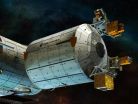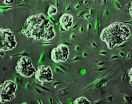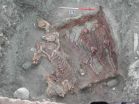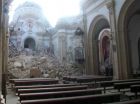(Press-News.org) Have you ever thought to use a clock to identify mineral deposits or concealed water resources within the Earth? An international team headed by astrophysicists Philippe Jetzer and Ruxandra Bondarescu from the University of Zurich is convinced that ultraprecise portable atomic clocks will make this a reality in the next decade. The scientists argue that these atomic clocks have already reached the necessary degree of precision to be useful for geophysical surveying. They say that such clocks will provide the most direct measurement of the geoid – the Earth's true physical form. It will also be possible to combine atomic clocks measurements to existent geophysical methods to explore the interior of the Earth.
Determining geoid from general relativity
Today, the Earth's geoid – the surface of constant gravitational potential that extends the mean sea level – can only be determined indirectly. On continents, the geoid can be calculated by tracking the altitude of satellites in orbit. Picking the right surface is a complicated, multivalued problem. The spatial resolution of the geoid computed this way is low – approximately 100 km.
Using atomic clocks to determine the geoid is an idea based on general relativity that has been discussed for the past 30 years. Clocks located at different distances from a heavy body like our Earth tick at different rates. Similarly, the closer a clock is to a heavy underground structure the slower it ticks – a clock positioned over an iron ore will tick slower than one that sits above an empty cave. "In 2010 ultraprecise atomic clocks have measured the time difference between two clocks, one positioned 33 centimeters above the other," explains Bondarescu before adding: "Local mapping of the geoid to an equivalent height of 1 centimeter with atomic clocks seems ambitions, but within the reach of atomic clock technology."
Geophysical surveying with atomic clocks
According to Bondarescu, if an atomic clock is placed at sea level, i.e., at the exact altitude of the geoid, a second clock could be positioned anywhere on the continent as long as it is synchronized with the first clock. The connection between the clocks can be made with fiber optics cable or via telecommunication satellite provided that the transmission is reliable enough. The second clock will tick faster or slower, depending on whether it is above of beneath the geoid. The local measurement of the geoid can then be combined with other geophysical measurements such as those from gravimeters, which measure the acceleration of the gravitational field, to get a better idea of the underground structure.
Mappings possible to great depths
In principle, atomic clock surveying is possible to great depth provided that the heavy underground structure to be studied is large enough to affect the tick rates of clocks in a measurable manner. The smallest structure that atomic clocks accurate to 1 centimeter in geoid height can determine is a buried sphere with a radius of about 1.5 kilometer buried at 2 kilometers under the surface provided it has a density contrast of about 20% with the surrounding upper crust. However, scientists estimate that the same clocks would be sensitive to a buried sphere with a radius of 4 kilometers at a depth of about 30 kilometers for the same density contrast.
Currently, ultraprecise atomic clocks only work in labs. In other words, they are not transportable and thus cannot be used for measurements in the field. However, this is all set to change in the next few years: Various companies and research institutes, including the Centre Suisse d'Electronique et de Microtechnique CSEM based in Neuchâtel, are already working on the development of portable ultraprecise atomic clocks. "By 2022 at the earliest, one such ultraprecise portable atomic clock will fly into Space on board an ESA satellite," says Professor Philippe Jetzer, the Swiss delegate for the STE-Quest satellite mission aimed at testing the general relativity theory very precisely. As early as 2014 or 2015, the "Atomic Clock Ensemble in Space ACES" is to be taken to the International Space Station ISS. ACES is an initial prototype that does not yet have the precision of STE-QUEST.
INFORMATION:
Literature:
Ruxandra Bondarescu, Mihai Bondarescu, György Hetényi, Lapo Boschi, Philippe Jetzer, Jayashree Balakrishna. Geophysical applicability of atomic clocks: direct continental geoid mapping. Geophysical Journal International. August 24, 2012. DOI: 10.1111/j.1365-246X.2012.05636.x
Contact:
Dr. Ruxandra Bondarescu (queries only in English)
Institute for Theoretical Physics
University of Zurich
Phone +41 44 635 58 04
E-mail: ruxandra@physik.uzh.ch
Surveying Earth's interior with atomic clocks
2012-11-12
ELSE PRESS RELEASES FROM THIS DATE:
Pneumonia remains the leading killer of children despite decline in global child deaths
2012-11-12
(BALTIMORE, MARYLAND) – Marking the fourth annual World Pneumonia Day, November 12th, world leaders and the Global Coalition Against Child Pneumonia are calling for major efforts in the fight against childhood pneumonia, which remains the number one killer of children under age five. Pneumonia claimed 1.3 million lives in 2011 alone, and was responsible for nearly one in five global child deaths.
"Pneumonia can be prevented and cured. Yet, for too long it has been the leading cause of global deaths among children. We know what to do, and we have made great progress ...
Colorful wall hangings contain toxic substances
2012-11-12
Traditional Swedish bonad paintings can contain toxic substances such as arsenic, reveals new research from the University of Gothenburg, Sweden, in which painting conservator and conservation scientist Ingalill Nyström analysed the paint and techniques used in the traditional painted wall hangings from southern Sweden.
Previous research into bonad painting has always originated in the humanities, from an art/cultural history perspective.
Bonad paintings are painted wall hangings that tell a story, often with a biblical theme, and were put up in farmhouses on special ...
Good quality of life for couples who adopt
2012-11-12
Couples who adopt after unsuccessful IVF treatment have a better quality of life than both childless couples and couples without fertility problems, reveals a study from the Sahlgrenska Academy, University of Gothenburg, Sweden.
A research group comprising midwives and doctors at the Sahlgrenska Academy, University of Gothenburg, studied quality of life five years after IVF treatment in 979 men and women in the Västra Götaland region.
The study compared couples whose IVF treatment had failed with those whose treatment had resulted in children, those who did not have ...
New statistical method offers automatic mitotic cell detection for cancer diagnosis
2012-11-12
Scientists have developed a statistical image analysis method which can assist in the grading of breast cancer by automatically segmenting tumour regions and detecting dividing cells in tissue samples.
The system, developed at the University of Warwick, promises to bring objectivity and automation to the cancer grading process which is used to determine the aggressiveness of the treatment offered to the patient.
Number of mitotic cells, cells which are dividing to create new cells, is a key indicator used by histopathologists for diagnosing and grading cancer.
At present ...
Scientists at IRB BARCELONA discover a key process that allows colon cancer to metastasize
2012-11-12
A team of 17 researchers, led by scientists Eduard Batlle and Elena Sancho in the Colorectal Cancer Laboratory at the Institute for Research in Biomedicine (IRB Barcelona), have determined that the ability of colon cancer to metastasize lies in the healthy cells, called stroma, that surround the tumour. Although the stroma has long been hypothesized to be complicit in this process, this study marks the first time that healthy cells in the microenvironment have been observed to play a fundamental role in allowing metastasis to occur in a specific tumour type.
The discovery, ...
Statement on the handling of risk situations by scientists
2012-11-12
In late October, Italian scientists have been sentenced for supposedly not having warned sufficiently against the severe earthquake of L'Aquila 2009. On occasion of this verdict, the German National Academy of Sciences Leopoldina and the French Académie des sciences publish a statement concerning the handling of risks situations by scientists. We forward the statement in the exact wording.
Joint Statement of the German National Academy of Sciences Leopoldina and the French Académie des sciences, 12 November 2012
On the science-based communication of risks following ...
Mongolia and the Altai Mountains: Origins of genetic blending between Europeans and Asians
2012-11-12
A group of researchers led by the Universitat Autònoma de Barcelona (UAB) has discovered the first scientific evidence of genetic blending between Europeans and Asians in the remains of ancient Scythian warriors living over 2,000 years ago in the Altai region of Mongolia. Contrary to what was believed until now, the results published in PLoS ONE indicate that this blending was not due to an eastward migration of Europeans, but to a demographic expansion of local Central Asian populations, thanks to the technological improvements the Scythian culture brought with them.
The ...
Elsevier launches new journal: 'Health Care: The Journal of Delivery Science and Innovation'
2012-11-12
New York, November 12, 2012 – Elsevier, a world-leading provider of scientific, technical and medical information products and services, is pleased to announce the launch of Health Care: The Journal of Delivery Science and Innovation.
Health Care provides a vehicle for communicating important advances in the study of cutting edge research on innovation in health care delivery, including improvements in systems, processes, management, payment, and applied information technology. The United States health care system is undergoing unprecedented reform; Health Care builds ...
Call for global monitoring of infectious diseases in dogs and cats
2012-11-12
Most emerging infectious diseases of humans come from animals. International health agencies monitor these diseases, but they do so only for humans and livestock, not for companion dogs and cats. A new study recommends a global system is needed to monitor infectious diseases of companion dogs and cats.
The study, led by Michael Day, Professor of Veterinary Pathology in the School of Veterinary Sciences at the University of Bristol and published online in Emerging Infectious Diseases, lists key infectious diseases that may be transmitted between dogs and cats and man ...
At least 6 major earthquakes on the Alhama de Murcia fault in the last 300,000 years
2012-11-12
Enjoying Spanish participation, an international group of researchers have analysed the most recent history of the Alhama de Murcia fault. They discovered that it has experienced six major earthquakes above 7 on the Richter scale. According to the scientists, this provides "convincing evidence" that the maximum earthquake magnitudes in the area are higher than originally thought.
Since 2001, researchers from the Universities of Barcelona, Leon, Complutense de Madrid (UCM), Coimbra (Portugal), Aahus (Denmark) and the National Autonomous University of Mexico have been working ...



